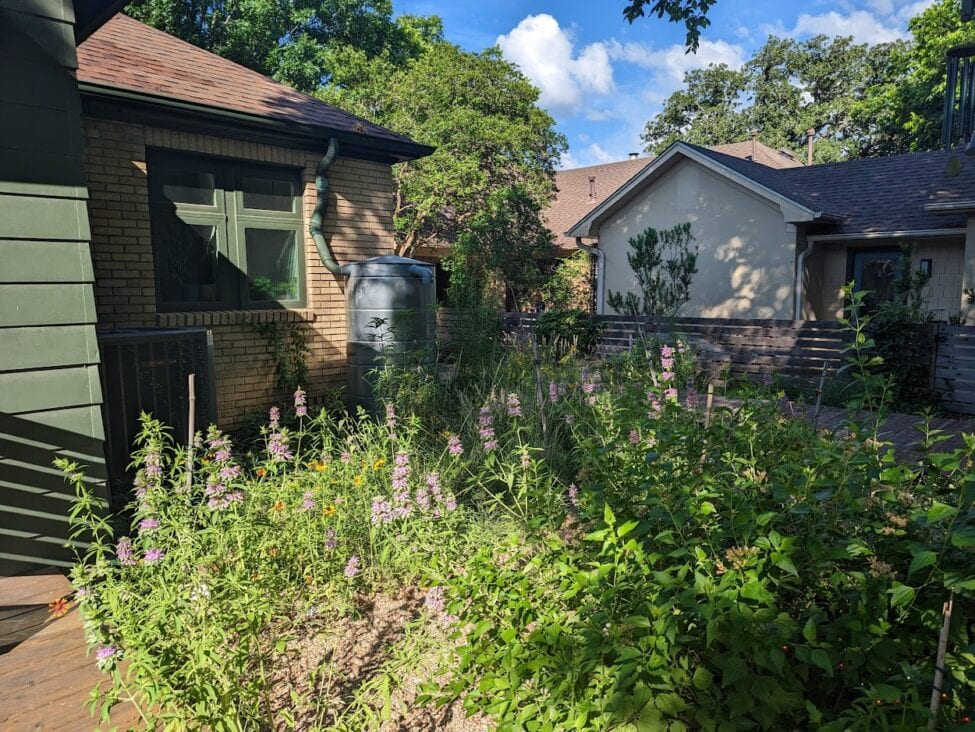Central Texas sits at a unique spot in Texas – it’s a crossroad of habitats, geologies, ecologies, and watersheds. One of the more significant transitions in our region is along the Balcones Fault, which divides the Edwards Plateau and the Blackland Prairie. Here, the pocket prairie assumes a particularly important role.

A prairie, also known as a grassland, is a type of ecosystem characterized by vast, flat or gently rolling landscapes covered primarily with native grasses, forbs, wildflowers, and other non-woody plants. Historically, many prairies have been converted to agricultural land, leading to habitat loss and changes in local ecosystems.
In the last 20 years, the notion of a pocket prairie has emerged as a promising strategy to help mitigate the loss of our native prairie land. These pocket prairies can take various forms and sizes, seamlessly integrate into urban or suburban settings, and showcase plant species native to the coastal prairie – an ecosystem that once sprawled across Texas and Louisiana. We’ve even tucked pocket prairies onto green roofs in our projects, like Frank!
We are big fans of utilizing pocket prairies in our projects and at our homes because:
- Pocket Prairies are Biodiversity Hotspots: Urbanization can lead to habitat loss and fragmentation, disrupting natural processes and causing a decline in local biodiversity. Pocket prairies act as oases amid concrete jungles, helping to counterbalance the negative impacts of urban development. They are like mini-ecosystems that host a remarkable array of plant and animal species. In Central Texas, where urbanization and habitat loss are ongoing concerns, these small habitats act as refuges for native plants and wildlife. By providing shelter, food sources, and breeding grounds for various species, pocket prairies contribute to maintaining a diverse and balanced ecosystem.
- Pocket Prairies Provide Resilience in the Face of Climate Change: Climate change poses significant challenges to ecosystems worldwide, and Central Texas is no exception. Pocket prairies are inherently resilient and adaptive. Native plants found in these prairies have evolved over centuries to withstand the region’s climate extremes, including droughts and heatwaves. Their deep-rooted systems stabilize soil, prevent erosion, and reduce the risk of flooding, making them vital in maintaining the region’s ecological integrity.
- Pocket Prairies are Pollinator Havens: Central Texas pocket prairies are essential for pollinators such as bees, butterflies, and other insects. As key contributors to plants and food production, these pollinators play a pivotal role in sustaining both natural ecosystems and agricultural activities. By providing nectar and pollen sources, pocket prairies support these pollinators, thereby aiding local agriculture and enhancing food security.
- Pocket Prairies have Educational and Recreational Value: Pocket prairies also hold immense educational and recreational value. They offer opportunities for nature enthusiasts, students, and researchers to learn about native plants, ecosystems, and conservation practices. By engaging with pocket prairies, individuals can develop a deeper appreciation for the region’s natural heritage and become advocates for its preservation.
- Pocket Prairies have Cultural and Historical Significance: These diminutive prairies hold immense cultural value, as they offer a glimpse into Central Texas’s past. Before European settlement, prairies were a dominant landscape feature, shaped by the region’s indigenous peoples and natural processes like fire. By conserving pocket prairies, we honor and reconnect with the history of the land, gaining insights into the traditions and practices of its native communities. These spaces also present opportunities for education and awareness, fostering a sense of appreciation for the natural heritage that surrounds us.
- Pocket Prairies are Excellent at Carbon Sequestration: Native grasses in pocket prairies are adept at sequestering carbon dioxide from the atmosphere. This natural carbon capture helps mitigate the impacts of climate change by reducing greenhouse gas levels, making pocket prairies valuable allies in the fight against climate change.
Pocket prairies may be small in size, but their impact on our ecosystem can be quite large. As Central Texas continues to grow, we can be mindful of the landscapes we plant to support a sustainable future.
Interested in growing your own pocket prairie? Our friends at the Wildflower Center have a thoughtful starter list to consider and Native American Seed has a perfect seed mix ready for purchase.
And of course, we would love to help you carve out a space to make a pocket prairie all your own! Be sure to contact us if you’re interested.